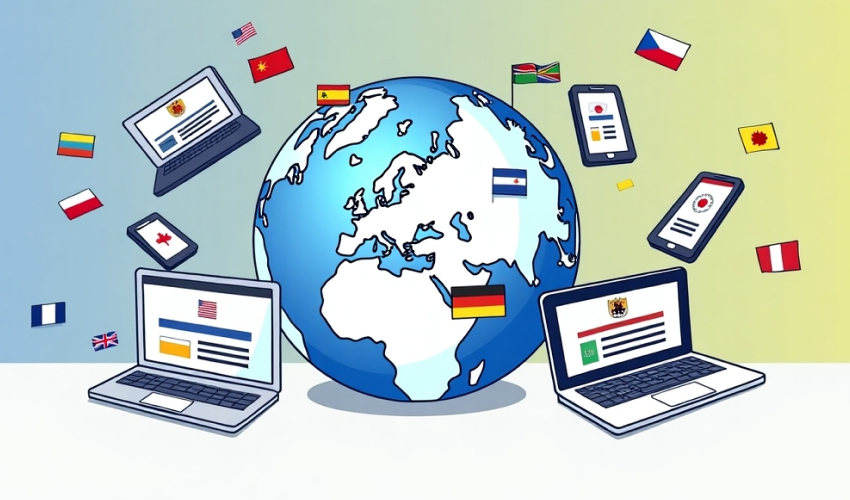Creating multilingual websites: how to effectively reach an international audience

If you plan to enter the international market and offer your goods and services to foreign buyers, you cannot do without a multilingual website. It will not only help eliminate language barriers, but also increase brand trust and conversion rates. Read more about creating a multilingual website in Ukraine in this article.
Who needs a multilingual website?
Such a resource is necessary for companies that already operate abroad or plan to enter the international market. First of all, these are:
- organizations that plan to open representative offices abroad;
- online stores that sell goods to other countries;
- SaaS startups;
- companies that operate in tourist areas or border regions and serve customers in several languages;
- educational institutions, cultural and educational projects;
- international charitable foundations (e.g., helping children, the elderly, animals), environmental organizations, human rights associations;
- blogs, media resources, and publishers with an international audience;
- companies looking for foreign partners.
A multilingual website is also relevant for local companies and organizations that operate in a multilingual environment. For example, if a company has many foreign employees or if its customers are of different nationalities.
Strategies for creating a multilingual website
How do you make a website in several languages? Before doing so, you need to decide on the format it will be presented in. There are two approaches:
- one website with translations into different languages (via subdirectories or subdomains);
- several separate resources, each of which is adapted to a specific market and language (different domains).
Each option has pros and cons that you need to be aware of before you start developing website.
Different language versions on one resource
This approach assumes that all language versions are hosted within a single domain. To do this, you can use:
- subdirectories — for example, portal.com/en/, portal.com/fr/;
- subdomains — en.portal.com, fr.portal.com.
Subdirectories are used when it is important to focus SEO efforts on a single domain. Subdomains are perceived by search engines as separate resources, so they are used when each language version requires greater autonomy.
Advantages of a single website
This option is convenient because the resource has a single common address (domain). Instead of “dividing” the attention of search engines between your different sites, you strengthen the position of your resource, which helps it rank better in search results.
A multilingual portal is convenient from a technical point of view, as it uses a single CMS, shared hosting, and a single SSL certificate for all language versions. It is easier for users to switch between languages, which makes the resource more comfortable to use and increases loyalty. It also takes less time and money to create.
Disadvantages
When developing a multilingual website, it is more difficult to adapt the interface, content, prices, or legal information to each market. Other disadvantages include:
- search engines do not always understand which country a subdirectory or subdomain is targeted at;
- incorrect settings can lead to problems with indexing and content duplication;
- adding new languages may require significant modifications, especially if the architecture was not originally designed for a large number of versions.
Problems often arise when implementing unique marketing offers, currencies, payment systems, and delivery options for each country. All elements have to be “embedded” into the overall structure, which can complicate the user experience.

Separate websites for each language
A separate resource with its own domain is created for each language or region — for example, portal.fr, portal.de, portal.es. These are fully-fledged autonomous resources adapted to a specific audience, and each can have its own content.
Advantages of separate websites for each language
This option is convenient because website localization allows you to deeply adapt not only the language, but also the following to the needs of a specific region:
- design;
- content;
- currency;
- special offers and promotions;
- payment methods;
- delivery;
- legal pages.
Each version has its own keywords, meta tags, and external links. This facilitates the promotion of the website abroad, as search engines clearly understand which country it is targeted at, especially if a local domain is used (e.g., .de for Germany).
Disadvantages
The structure of each multilingual website must be developed separately. This requires not only significant financial investment, but also the involvement of specialists who understand the local market and will:
- translate the website into other languages;
- adapt the content;
- provide technical support;
- promote the website using SEO;
- regularly update the information.
Each resource requires separate domain registration, hosting connection, technical support, content filling, and promotion. Accordingly, this takes a lot of time, because working on such a resource will take longer than if it were just a text translation.
Website promotion in foreign markets from Megasite
The IT company Megasite in Kyiv offers comprehensive SEO promotion of websites in foreign markets, including:
- creation of a multilingual website from scratch;
- website localization services, including content;
- SEO optimization;
- competitor analysis;
- creation of local links.
We develop effective advertising campaigns in search engines and social networks. We also work on brand reputation, using analytical tools to improve results and increase visibility in international markets.
Want to learn more about developing a multilingual website? Contact our manager — and he will answer all your questions!
Your project
Call/write:


